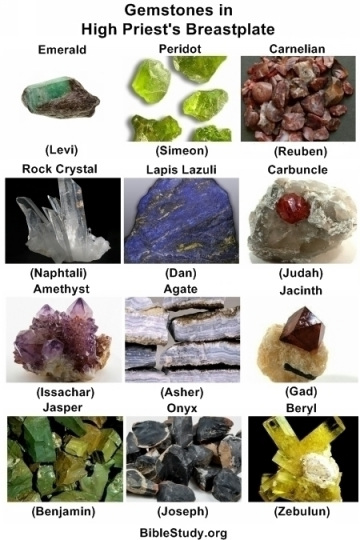Foreshadowing the ministry of Jesus Christ (Hebrews 2:17, 4:14 to 7:28, 9, 10), the High Priest represented all of God's people before the Eternal. While performing his priestly duties he wore a breastplate, designed by the Lord, which had twelve special gems in it.
The High Priest's duties were the same as any other Levite who served the Eternal with a few exceptions. For example, only He could wear the breastplate containing precious gemstones embedded in it. Additionally, only he could perform the tasks required on the Day of Atonement (Yom Kippur). He was also the only person who could use two (likely) special stones referred to in the Bible as the Urim and Thummim.
One For Each Tribe
The special breastplate of gems made for the priest (sometimes referred to as the "breastplate of judgment" - Exodus 28:30) had each of its precious stones engraved with the name of one of the twelve tribes of Israel (Leviticus 8:7 - 9, Exodus 28:17 - 20, 39:10 - 13).

The main purpose of the High Priest's breastplate was to be a memorial (reminder) before the Eternal. It was meant to remind him that he represented all the people, as mediator and intercessor, before the Lord (Exodus 28:29, 39:7). The gems embedded in it were aligned into four rows containing three stones each.
And you shall make the breastplate of judgment with embroidered work. After the work of the ephod, you shall make it; of gold, blue, and purple, and scarlet, and fine-twined bleached linen, you shall make it.
It shall be square, doubled; a span the length of it, and a span the breadth of it. And you shall set in it settings of stones, four rows of stones. The first row shall be a sardius, topaz, and carbuncle in the row.
And the second row: an emerald, a sapphire and a diamond. And the third row: an opal, an agate, and an amethyst. And the fourth row: a chrysolite, an onyx and a jasper. They shall be set in gold in their settings (Exodus 28:15 - 20, HBFV).
Scripture does not directly state which breastplate gems had a particular Israelite tribal name attached to it. First century Jewish Historian Josephus (who came from a priestly family), however, states that the names were placed according to birth order (Antiquities of the Jews, Book 3, Chapter 7, Verse 5). This makes sense, since the Bible does state that the tribes were to be listed, six names each in birth order, upon two onyx stones the High Priest wore on his shoulders (Exodus 28:9 - 10).
The birth order of Jacob's (Israel's) male children, from firstborn to last, is Reuben, Simeon, Levi, Judah, Dan, Naphtali, Gad, Asher, Issachar, Zebulun, Joseph and Benjamin (Genesis 29 - 30).
Name Order
There is an important fact we need to understand before we can label each of the gems in the breastplate with a tribal name. The method most people in the Western world (including those who translated the Bible into English) read and write is in the direction of left to right (the method you are using to read this text). Ancient Hebrew, however, wrote and read in the direction starting on the right side of a particular line of text and went left.
This means that the engraving of the gems, in the birth order of Jacob's son, begins on the far right of the breastplate as opposed to starting on the far left. For example, Reuben, the firstborn son of Jacob, should have his name engraved on the far right gem in the first row.
Going right to left, Simeon's name is on the middle stone, while Levi's name is on the row's far left stone (there are three stones in each row). Judah, the fourth son, has his name on the far right precious stone in the second row, and so on (Gemstones in the Breastplate, page 7).
Hebrew's right to left method of reading and writing also affects the exact placement of the precious stones within the breastplate. For example, based on this study series, the first three stones in the first row (Exodus 28:17), using our English method for listing things left to right, are the Carnelian, Peridot and an Emerald. The actual placement of the stones, however, begins with the first gemstone (Carnelian) placed on the far right of the first row.
Putting it all together, the image on this page shows the placement of gems in the High Priest's breastplate (from the point of view of a person looking at it while the priest is wearing it) along with the name engraved on each one.